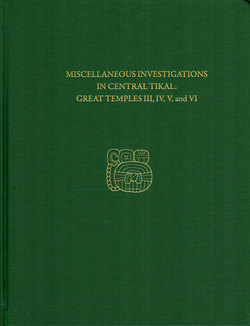Читать книгу Miscellaneous Investigations in Central Tikal--Great Temples III, IV, V, and VI - H. Stanley Loten - Страница 12
На сайте Литреса книга снята с продажи.
ОглавлениеI
Introduction & Acknowledgments
During preparation of the topographic site maps for the Tikal Project, a total of 2,120 individual structures were numbered (TR. 11:10). Excavations touched only a fraction of this total and various reports detail their architectural features. The remainder includes many that have fully collapsed—presenting mere mounds of debris—quite a few with features still in place and accessible without excavation. Tikal Report 23A (2002) presents data on some of these “standing” structures, and this volume provides more.
In the nature of things, we have less information for some structures than we have for others; 6F-27 (Temple VI) was partially cleared and a skull burial was excavated; minor excavations, including a short axial tunnel, were done on Temple IV; Temple III had no more clearing than is mentioned below; in Temple V some cuts were made for access to roofcomb chambers. As a matter of policy recording was done with minimal disturbance to the vegetation. In many cases, mortar has degraded so that tree and plant roots are the only things holding these fabrics together. Plant removal would drastically hasten collapse. Measuring had to be done within and around the mantle of vegetation.
A few small cuts were made to locate corners and base lines where it appeared that the data could be obtained with very little disturbance. Some upper parts were measured for plan data along the lines where wall faces emerged from debris. Since many wall faces are not exactly vertical, these measurements include small dimensional errors. In the case of Great Temple IV (Str. 5C-4), restoration was underway at the same time that recording was being done and some features are the restored versions.
Sculptural details, where present, are generally poorly preserved and can be indicated only approximately. One exception to this is the sculptural feature on the upper part of the rear axial outset of Great Temple III. Often vaults have partially collapsed, presenting sectional details that reveal processes of construction otherwise inaccessible.
In TR. 12:37 (1982), TR. 23B was projected to be jointly authored by myself, William R. Coe, and Christopher Jones. Sadly, both Jones and Coe are no longer with us. Jones’s material is now to appear in 23C and 23D. As a result, TR. 23B presents data on four of the six Great Temples. Great Temples I and II appear in TR. 14 (1990). The greater level of detail available for these two structures reflects the impact of excavation.
From the start, Tikal was distinguished by a wealth of relatively well-preserved standing architecture. One Tikal Project objective was that of putting on record all accessible details of structures that were not scheduled for more intensive investigation. Since standing architecture was always at risk of collapse due to on-going erosion and tree growth, it was felt as a responsibility that all extant features not concealed by debris should be recorded as soon as possible. This report presents one set of these “standing architecture” examples. Others appear in TR 23A (2002), and TR 23C and 23D (forthcoming).
The four structures presented here, Great Temple III, IV, V, and VI, together with Great Temples I and II, stand as the dominant features of the city center. If tree growth were to be removed, five of these would be immediately obvious as a coherent set of major monuments (Great Temple VI is remotely located but connected with the others by plaster paving). All but Great Temple V represent Late Classic construction and can be associated with known rulers. It is tempting to think of them as funerary monuments, but this is only a supposition. Their relationship with rulers may have been much more complex.
Tikal Project personnel who measured these structures and prepared the drawings that provided the data for this report are noted in the introductory paragraphs for each structure. Manuscript preparation has greatly benefited from the editorial work of Barbara Hayden, Simon Martin, Jim Mathieu, and Page Selinsky. Alessandro Pezzati and Virginia Greene assisted greatly in providing various types of material. Alert outside readers spotted problems and made helpful suggestions. I wrote the reports and must take responsibility for any errors or omissions.
